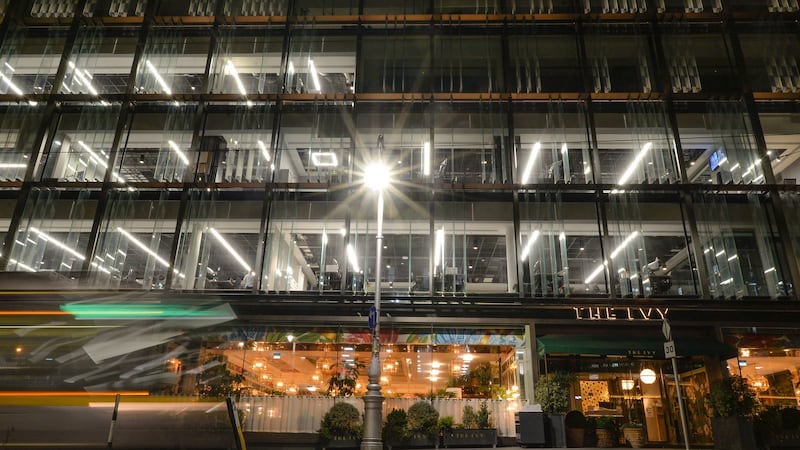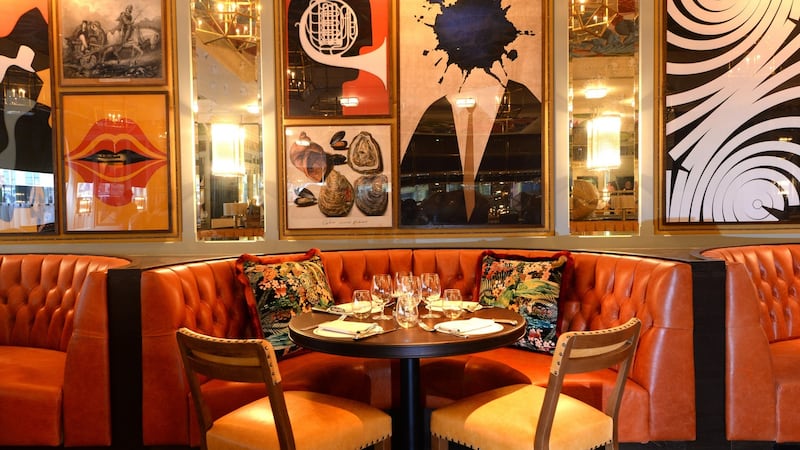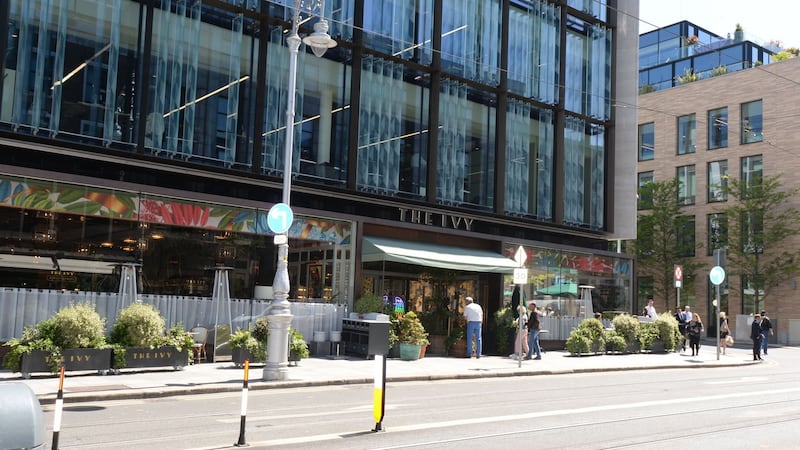Dining out has been a frequent subject of debate since coronavirus took hold in early 2020, and a key talking point of the past few weeks. Indoor dining in restaurants and pubs – originally planned for July 5th – will now resume no later than July 26th.
The Government announcement this week of the new date was welcomed as a "giant leap forward" by Adrian Cummins, chief executive of the Restaurants Association of Ireland, and criticised as a "reckless mistake" on behalf of a "private business lobby" by Opposition TD Paul Murphy.
These are just two of many views expressed on the subject in recent days. Which of them right?
This story is about what happened in one restaurant in December 2020. It is but one example from numerous clusters across Ireland that constituted the Christmas spike in cases and led to a 4.5-month lockdown.
There's a cautious approach in the Dawson Street establishment, and an emphasis on safety for both staff and customers
We tell the story – which was researched in January – not to be alarmist: the percentage vaccinated is increasing after all, and these precise patterns are unlikely to be repeated in the coming weeks.
We tell the story not to single out this business. This could be any large restaurant or indoor pub with busy throughput. The volume of customers and staff indoors, the fact that diners could not wear masks while eating, and the underestimated virulence of Covid-19 at the time made this and other outlets vulnerable to infection spread, despite safeguards.
We tell the story to show how easy it is for Covid to take hold in a restaurant environment. Many younger hospitality workers, even now, remain unvaccinated, and the commercial pressures facing hospitality businesses have not lessened since December.
The research for this article was conducted in January, shortly after the events. Now, as restaurants prepare to reopen, the story acquires a new public-interest relevance.

November 2020
In late November, with restaurants shut for two months because of Covid-19 transmission risk, the Government decides to allow indoor dining from December 4th, putting it at odds with advice of the National Public Health Emergency Team (Nphet), which has called for more caution in reopening hospitality.
Even ahead of reopening, bookings are strong for pre-Christmas, traditionally the busiest and most lucrative period for restaurants.
Friday, December 4th
The Ivy Dawson Street restaurant in Dublin reopens, along with many others across the industry. The stylish 200-seat all-day outlet, the only Irish branch of Caprice Holdings’ Ivy Collection UK chain, has been operating in Dublin since 2018.
There’s a cautious approach in the Dawson Street establishment, and an emphasis on safety for both staff and customers. Staff repeat online training on sanitising protocols and distancing, and the start times for evening shifts are staggered, to avoid staff arriving simultaneously and interacting unnecessarily.
Experienced waiter “Pat” says the Ivy is “very busy, from breakfast till dinner, and seemed almost fully booked, even on Monday and Tuesdays”. They stick to public health’s stipulated 105-minute time limit and €9 minimum spend.
The sanitiser is broken through most of December. 'It was filled, but didn't work.' He doesn't know if anyone reported it. Symptom forms stop after about a week, he says
There are sanitisers throughout the restaurant for guests and staff. Managers check staff temperatures at shift starts. Waiters wear reusable masks bearing the Ivy logo. Staff dress in the changing rooms, many using the iron, wearing masks.
One employee’s sole job is sanitising surfaces and door handles.
“Frank” (not a waiter) feels it’s well prepared for reopening, with reduced table numbers, separated by plastic panelling.
He says management is almost “militaristic” about precautions, urging staff not to move unnecessarily between different areas of the restaurant. They were “very f***ing strict. It was surprising.”
Frank overhears reception explaining precautions during bookings, and says if customers made for the toilets without a mask, a manager or waiter would point it out.
Though there might be slippage in protocols initially, and chefs especially find it hot working in masks, Frank says, overall staff stick to rules. A loud conversation is overheard when a worker takes off their mask, a manager furiously saying it’s putting others at risk.
The well-oiled machine appears to be working, but some observe that it is not operating perfectly. At the staff entrance workers scan fingers to clock in and out, touching a keypad. Pat says the nearby sanitiser is broken through most of December. “It was filled, but didn’t work.” He doesn’t know if anyone reported it.
Symptom forms stop after about a week, he says.
“It was one of the busiest times I’ve ever worked in the Ivy,” says Pat. “Too busy to stick to all the procedures.”
For example, “menus were supposed to be wiped between use but that wasn’t always possible with the volume we were doing during the day”.
Was management aware? “You’d have to be in your own world not to know they weren’t being followed properly.”
Monday, December 7th
Pat reckons staggered shift starts stop around this day, with all evening waiters now arriving at 5pm. (Morning shifts were always staggered.) Though boards prevent people touching off one another in the small staffroom, now you could have three or four people changing together at the same time, for example.
Another staff member, “Greg” says customers are less easy-going than they were in summer, when they often came and went without masks. In December, he says, guests wear masks automatically, “like wearing shoes going out. Although there were some customers who were not respectful of that and came close to ask us things. But we asked customers to step back.”
Greg is conscious of an infection risk from surfaces; they’re supposed to sanitise every surface, but under pressure they might sometimes skip.
Thursday, December 10th
Deborah Martin, working in PR from home since March 2020, meets three friends for dinner at the Ivy. Two days later all four feel ill within an hour of each other: “We started to fall like flies.” All test positive for Covid-19, and in turn pass it on to family members.
Martin feels certain they caught it dining together indoors, the only time all four were together. But it’s impossible to be sure where anyone picks it up, whether they all caught it in one place, or if one asymptomatically brought it in.
When Martin and her friends arrive for their 7.45pm booking, “it was quite busy and they were running late”. They wait in the foyer, then at the bar, before being seated at a corner table around 8.25pm. They leave at 10.15/10.30pm. “There was no rush.”
While waiting she is aware of people moving around, “up and down to the loos, without masks, touching the handrail. Guests were brushing up against me. It felt uncomfortable.” She recalls a busy restaurant, where staff seemed under pressure, moving quickly.

Martin has a private test and reports her positive result to HSE. Her companions were tested and contact-traced by HSE. They are very thorough, says Martin, asking where they were seated, waiting locations, timelines.
Martin rings the restaurant’s Dublin number, reaching what she says sounds like UK head office. She informs them of the cases, requests they pass the information and her contacts to the Dublin management. “Not one person got back to me.”
They’d a nice evening. Her first time out since March, but “it wasn’t worth it”, given the outcome.
A cluster/outbreak is defined as two or more cases of lab-confirmed Covid-19 infection (symptomatic or not), or one lab-confirmed case and at least one other illness with Covid symptoms.
Public health authorities, which analysed the Ivy outbreak, cannot comment on individual cases. Dr Fionnuala Cooney, director of public health for Dublin South, Kildare and West Wicklow explains in a statement: “When a case of Covid-19 is identified which is linked to the hospitality sector, public health professionals discuss directly” with the person/family about their contacts, and also discuss “directly with the business, undertaking a public health risk assessment”.
Recommendations, including any exclusion of staff, are made, and responses may differ, depending on circumstances identified by public health, she says.
Some customers seem to be on a 'restaurant crawl', with two or three bookings a night, ordering one course and drinks
Dr Cooney points out “a particular feature of restaurants and bars is that customers are not wearing masks or face coverings for much of their time at the setting. This can increase the risk of transmission of Covid-19.”
We know of another group, two couples, who all test positive after dining together at the Ivy in December; one travels for work and it is not clear that their infection was linked to their dining experience as the virus was circulating widely at this time.
Mid-December
The restaurant is now very busy. Pat feels it is “regularly overbooked and understaffed”.
The all-day restaurant is believed to normally serve around 800 people daily. Tables are rearranged for distancing, but waiter Pat reckons that, because the 105-minute limit means faster turnaround, and the restaurant is still doing 700-800 covers a day: “They actually shot up through the month of December.” On the other hand, the time limit reduces how much people drink, Pat adds.
Some customers are “blasé, they didn’t mind going as normal to a restaurant”, while others, more conscious of risks, “kept their distance”. Pat describes being aware occasionally of “some tables watching you, making it quite obvious, by their facial expression, putting masks on whenever you came to the table.”
Others seem to be on a “restaurant crawl”, with two or three bookings a night, ordering one course and drinks. Initially the restaurant tries to insist on at least a main course, but if customers make a fuss, they just have a starter.
Pat describes some discomfort waiting tables, being aware through December of the numbers of interactions on a shift. “The amount of times you have to go to a table in one hour and 45 minutes: pick up and put down drinks, food, clearing the table. You’re making contact with the table maybe six or eight times, depending on what they’re getting.”
Rumours spread within Dublin hospitality about an outbreak of Covid at the Ivy, among staff and diners
Pat feels not enough people were rostered front-of-house. “I think they overbooked the restaurant for the amount we could have done safely, and there was too much work to do to stick to all the regulations.”
The Government’s Return to Work Safely Protocol requires “strong communication and a shared collaborative approach between employers and workers”, and stipulates workplaces appoint a lead worker representative (LWR) “charged with ensuring Covid-19 measures are strictly adhered to” who “should be clearly identifiable in the workplace”, working with a Covid-19 response manager.
At an unrelated disciplinary meeting on August 20th, Unite trade union, which represents some Ivy staff, pointed out to management it didn’t have a LWR and wasn’t in compliance. The restaurant had said a senior manager was in the role.
Staff we spoke to weren’t aware of who the LWR was, or of the requirement for one.
Weekend of December 18th-20th
An employee, “Ann”, whose job involves contact with both front and back of house, starts to feel sick, and tests positive. Another employee, “Cori”, also tests positive around this weekend. Both are symptomatic but not very sick, and unable to narrow down where it was contracted.
Over the weekend Greg hears of two other positive tests among colleagues. He isn’t worried as he hadn’t been in close contact with them. “At the same time I knew someone might catch it so I was prepared.”
Rumours spread within Dublin hospitality about an outbreak of Covid at the Ivy, among staff and diners.
It’s the last weekend before Christmas, the height of the season. “People kept piling in” says Pat. “It was unbelievably mad.”

Monday, December 21st
Staff get Tuesday appointments for Covid testing by HSE on the premises. Those who speak to The Irish Times say there was no explanation of why public health was mass testing all staff. Management present it as a precaution and does not notify staff of positive cases.
Dr Cooney points out infectious disease legislation mandates investigating “the nature and source of infection”, and “stopping onward transmission of the virus is what it most important in our work as public health doctors.”
Without breaching HSE’s duty of confidentiality, she observes generally of workplace outbreaks, if there are only one or two cases, and their contacts are tested/advised to isolate. Depending on circumstances - environment, work practices, travel arrangements, accommodation and social practices - they decide whether to test all staff or not, and whether to close or keep open the facility. Workplaces where possible cases include both staff and service users - including hospitality - are categorised separately.
Greg says staff speculate about the testing, wondering if there are more than the two confirmed cases. “It wasn’t easy because a lot of staff were panicking and some were anxious. I was trying to keep calm ... Others were more nervous, saying they were afraid they might have the virus as well, probably because they were working the same shifts.”
Some staff are out sick at the weekend, but colleagues don’t know if it’s due to Covid-19 or not.
Tuesday, December 22nd
Not being informed, says Greg, “made it worse. We didn’t know anything definitely, but people exaggerate and so we don’t know the truth. I would like to have known. But on the other hand I would have been panicked if I had known.”
Another employee who tested positive echoes this: they heard “a lot tested positive” but it was kept quiet. While recognising it’s a difficult situation to handle, it was dealt with badly, they say.
Rumours, like the virus, spread like wildfire. Staff describe managers on the floor shaking their heads in disbelief, some workers openly wonder how they can still be open. Some are nervous about working; at least one leaves.
Closure is communicated with staff via a screenshot on a WhatsApp group, of an Instagram post that Ivy would be shut on the 24th
An area in the basement is sectioned off for HSE testing. Everyone, rostered or not, is tested, says Frank. “We were told we’re closing tomorrow but everyone will be tested before we go. They took care of us, all things considered.”
On the morning of December 22nd, an Irish Times reporter rings and asks both the Ivy’s general manager and a PR representative about the situation. He’s told while there have been cases among diners, “the HSE has alerted the restaurant to that”, the restaurant is open and trading normally. He’s told there was no identified cluster among staff, and it had been given the all clear by the HSE.
But public health officials are on the premises at this point, testing all staff.
Wednesday, December 23rd
Many staff receive results. It’s unknown how many are positive. We’ve spoken to or are aware of at least three staff who were positive before the mass testing, and at least one who hadn’t symptoms but tested positive on the 22nd. This is aside from the at least eight positive diners. Information also circulates informally among staff about additional positive tests of workers.
The restaurant stays open all day, closing at 11pm. It is understood bookings for Christmas Eve are cancelled. Closure is communicated with staff via a screenshot on a WhatsApp group, of an Instagram post that Ivy would be shut on the 24th.
Thursday, December 24th
It is Christmas Eve, and the restaurant has closed a day early. Despite the Return to Work protocol requirement for communication and collaboration, staff who speak to The Irish Times say management have not communicated with staff about cases or how they have been handled at any point. Staff remain in the dark about the extent of December’s outbreak.
How do viruses spread in hospitality?
The Ivy is a very large restaurant, serving for over 12 hours a day, seven days a week. Pat estimated 700-800 covers a day in December. Some time ago staff was estimated at 150, but it’s believed there were fewer in December (making it less crowded, but more challenging to observe protocols). Even a conservative average of, say, 600 diners a day for the 19 days it was open suggests in excess of 10,000 diners. According to the Health Protection Surveillance Centre’s Epidemiology of Covid-19 Outbreaks/Clusters in Ireland, 60 outbreaks in restaurants/cafes were notified between August 2nd, 2020 and the second week of 2021 (restaurants were not open for a significant part of that time). This represents just 0.7 per cent of all outbreaks in the period.
The Ivy’s response
We sought to include Ivy management’s perspective on handling an outbreak in hospitality, an experience shared by many other organisations. The Ivy declined to discuss December’s outbreak. When we contacted the Dublin general manager in January, he said that he couldn’t speak for the Dublin restaurant and that the marketing team in London head office would respond.
Earlier in the year, we asked an Irish strategic communications company representing the Ivy about diners and staff who tested positive, who was Covid-19 lead worker representative, and whether staff were told about positive cases – among other questions. The response didn’t address the questions but said: “The Ivy Dawson Street health and safety policies are fully in line with the Government’s guidelines. We take the health and safety of our guests and staff as paramount and had put in place rigorous measures designed to ensure the safety of our employees and guests alike.”
In recent days, The Irish Times once again invited the Ivy to respond to questions about the events in this article. The company chose not to comment further.
‘Precarious work’
Brendan Ogle of the union Unite is adamant: "There was a cluster in the Ivy, it's well known in hospitality, and workers need it exposed. Why do Ivy refuse to confirm numbers? ... We're aware of the nature of precarious work, the fear it engenders. The Ivy knew about the virus cases, which was a great cause for concern, and they stayed open."
It could have been any large restaurant; the whole sector was vulnerable at this time. And restaurants opened last winter with the backing of the Government. However, as Ogle reminds us, they did so against Nphet advice ... “and hey presto”.
Staff members’ names have been changed but are known to The Irish Times














